The country must be built with violence: Old propaganda will be like new in the Donbas.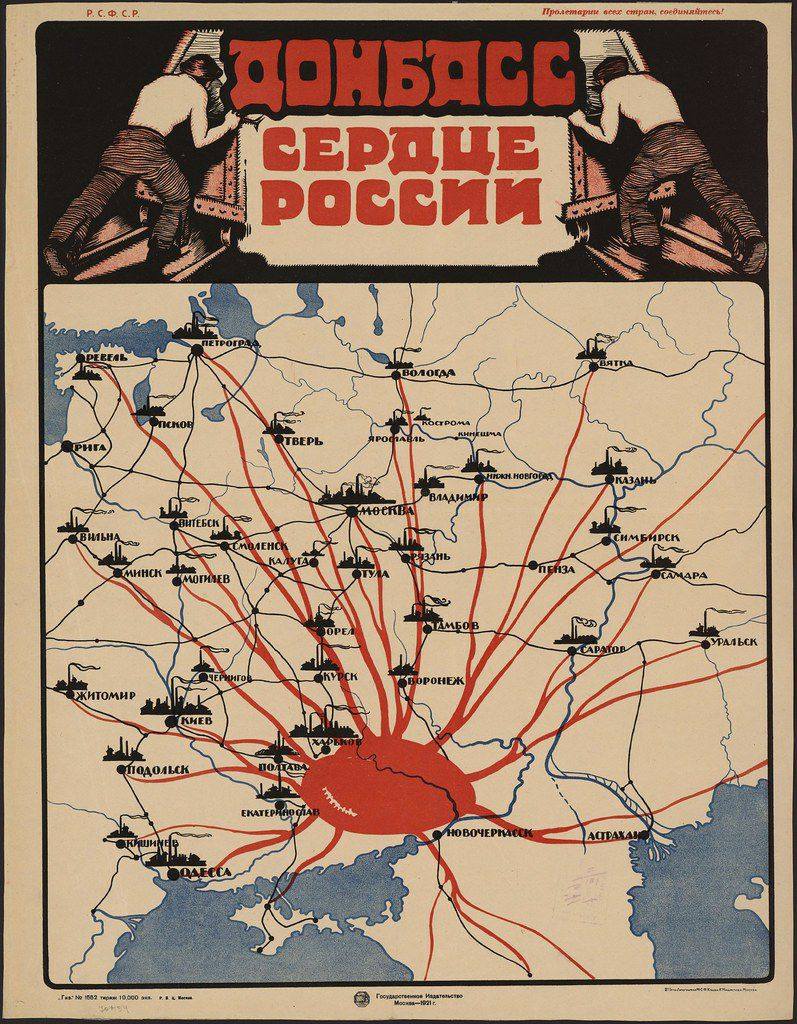
"Donbass - the heart of Russia". Poster from 1921. Unknown artist.
111 days of war in Europe, and the epicenter is the heavily industrialized Donetsk Basin. The natural resources of the Donbas are both a blessing and a curse.
The first salt reserves were discovered in the Donbas in the late 17th century. Then the city of Slavyansk was built a little north of today's Kramatorsk, and the first naval port at the mouth of the Azov Sea was founded in Taganrog. In the early 1720s, the first coal fields were explored, and the first mining operations began around 1770. Eight years later, the port city of Mariupol was founded, and from 1882 the coal could be transported from the mine tunnels in the depths of the Donetsk Basin via the newly built railway to the harbor, began a large-scale electrification. Several large iron and steel plants in the Donetsk region were built by foreign entrepreneurs, such as the Welshman John Hughes and the Americans Rothstein & Smith.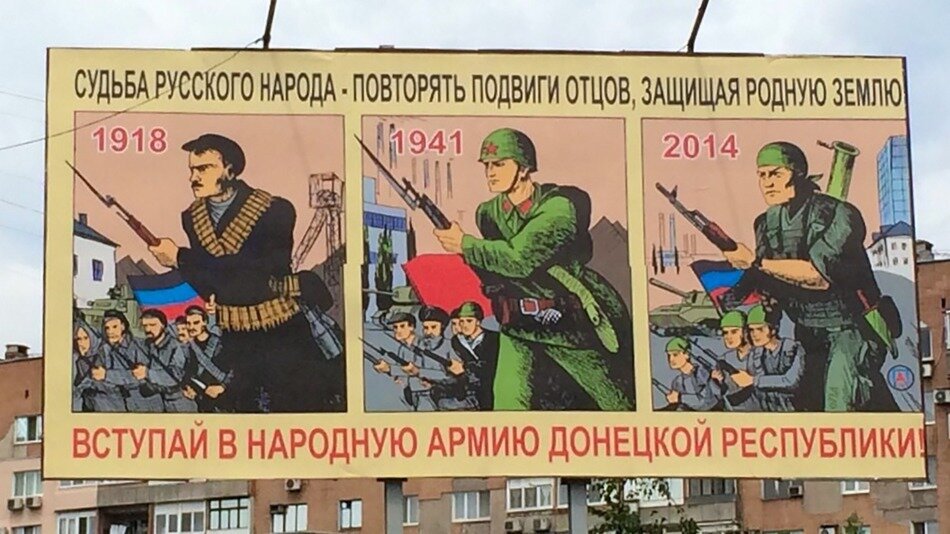
A three-part poster that was hung in the streets of the self-proclaimed "People's Republic" of Donetsk in 2014:
"The fate of the Russian people is to repeat the fathers' exploits and defend their homeland. 1918 - 1941 - 2014: Join the People's Army of the Donetsk Republic! »
Today - after one revolution, seventy years of Soviet rule and a couple of decades of Ukrainian independence - new lords are fighting for power in the Donbas. They are neighbors and allegedly brothers, but have soon hit the region harder than any foreign occupier in Ukraine's history.
This week, eight years ago, readers of Russia's response to Kapital, a norwegian weekly magazine "Ekspert", were served a well-known message from the time of the revolution. With retro letters on a blood-red background in the edition 9. – 16. June 2014 it said on the front page: «Donbass - the heart of Russia». The slogan was taken from a famous Soviet propaganda poster in 1921, in which Donbass was drawn as a blood pump with a network of veins. Here the industrial resources were to flow out to all the cities of the new union of socialist Soviet republics.
The slogan was probably taken from a headline in May 1918. By then the area was German-occupied, coal production had dropped dramatically to about a sixth of previous volumes, and the newspaper Vozrozhdenije ("Rebuilding") in Kharkov wrote: "The Donetsk Basin is the heart of Russia, and if this heart stops knocking, life in Russia will come to a standstill ».
Over ninety years later, in 2014, three-part posters were hung in the self-proclaimed "People's Republic" of Donetsk. We may not have noticed it very well then, here in our peaceful north. But the message was the same that is now being pumped out of the Kremlin: "The fate of the Russian people is to repeat the fathers' exploits and defend their homeland. 1918 - 1941 - 2014: Join the People's Army of the Donetsk Republic! »
The past is an eternal source of ideological pep talk and war cult in Russia. Did you think we had seen a new level of brutality in 2022? Yes - but it was pretty bad a hundred years ago too.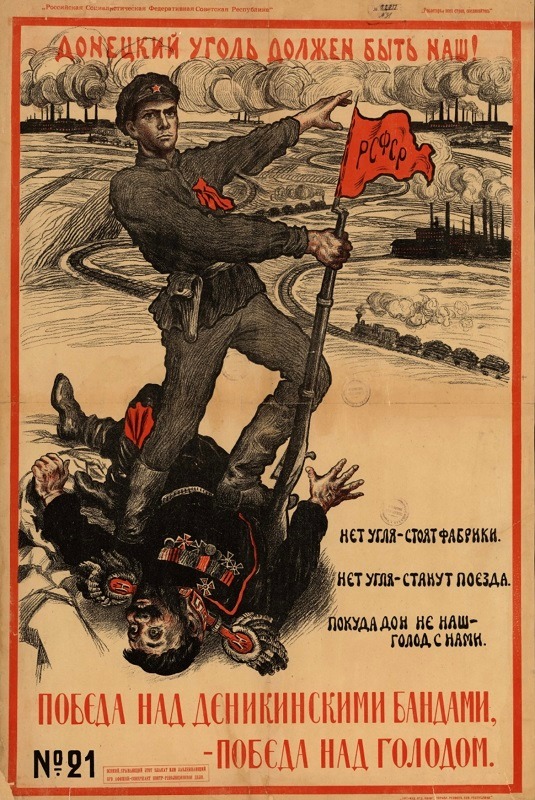
"The Donetsk litter must be ours!" Poster from RSFSR 1919. Designer: Vasily V. Spassky. Below the main message is further:
"The factories are without coal. Without coal, the trains stop. As long as Don is not ours, hunger is with us. Victory over Denikin's gangs is victory over hunger. "
Already during the October Revolution and the ensuing civil war between the "Reds" and the "whites" (the anti-Bolshevik white guard), the Bolshevik authorities had a heavy focus on the Donbas. Throughout 1919, there were fierce battles over natural resources in the Donetsk Basin. Hunger ravaged, the economy was on its knees, and the coal in the Donbas was absolutely central as revolutionaries and counter-revolutionaries fought on the battlefield.
On New Year's Eve 1919, Donbas was finally "liberated" by the Reds. As motivation, they had a poster in which a soldier from the Red Army stood on the chest of one of Anton Denikin's generals and smashed him with the butt of a rifle, with the flag of the new Russian Socialist Federation of Soviet republics waving over the muzzle. The message was unequivocal: "The Donetsk litter must be ours!" Without coal, no progress for Russia. A victory over "Denikin's gangs" was also a victory over hunger.
But the Russian Civil War as such was not over with this, it lasted almost until the end of 1922, and the poster presses went hot. The drawing of the beating heart from 1921 was particularly telling of the scope of the ambitions: The blood vessels run from the heart in Donbas to Odesa in the southwest, through Crimea and out to the port city of Sevastopol, in the east to Novocherkassk and on to Astrakhan on the Caspian Sea. They also run south, to Georgia, Armenia, Azerbaijan, even Turkey. In the northeast - towards all the industrial cities of Russia. To the northwest - to Kyiv and Zhitomir. Further northwest - towards Petrograd (St. Petersburg), Riga and Reval (Tallinn).
It was probably the plan also in 2014 to restore this blood vessel network. Crimea was placed under Russian administration in March eight years ago, and the self-proclaimed "People's Republic" of Donetsk was proclaimed in April 2014. Mariupol was besieged even then, but the city still did not become separatist territory - not then. For on almost exactly this day, June 13, 2014, the city was recaptured by Ukrainian authorities after exactly two months of occupation, which was a dash in the bill for Russia. For eight years, the Ukrainians celebrated June 13 as Mariupol's Liberation Day, not many miles from the front lines in Donetsk and Luhansk. During these years, a large-scale urban development was carried out, whose working hours and invested funds are now only surpassed by the number of deaths.
Leading Bolsheviks are said to have said that posters were a more effective victory strategy than bullets and cannons. It is by no means surprising that the words and images of the time still have impact, and perhaps even stronger now. Because with new media and new technology in our complex modern world, propaganda is pumped out faster than the heart supplies the years with blood. In two months, the Azov Sea's largest port city and several steelworks have been laid in rubble. The flag colors of Mariupol's city letters are overpainted in red, white and blue, and not only that: the fine folk ornaments that were painted on the wall under the letters, taken from national folk embroideries, have also been erased.
At the same time, construction roads are being built from the Donbas to the Crimea with life and desire. It is more convenient than having to carry steel, coal, grain and military equipment across the Kerch Bridge. At least when one wants to subjugate Central Europe's largest country, if we do not count Russia itself.
Over the past week, Putin has not only thrown off the mask, he has exposed his entire post-imperialist wolf hunger. Gone is the rhetoric about the threatened Russia that was pressured by NATO from all sides and was forced to invade Ukraine, poor thing. The new slogan is: "Take back and strengthen". Take what is "ours," whether it was a hundred years ago under Lenin, or three hundred years ago under Peter the Great. So too with Donbas. If we are to take the reborn tsar at his word, it only remains to be seen whether Sweden and Gotland are next in line.
© Yngvild Sørbye
Her er original-innlegget fra Facebook
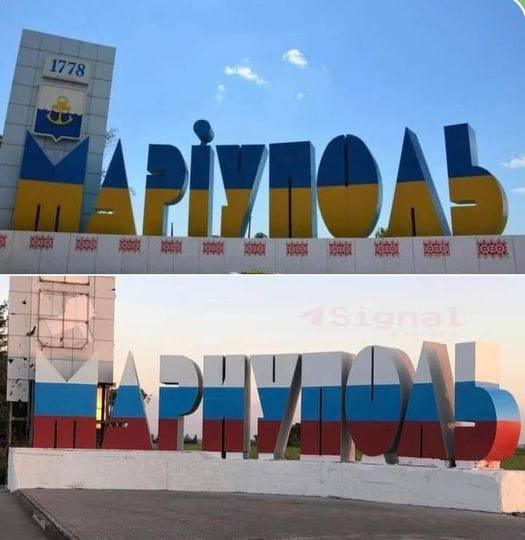
Mariupol - the gateway and port of export from the Donbas on the Azov Sea.
The city letters have now been repainted, and the national Ukrainian folk ornaments have been erased. Photo from May / June 2022.
Oversatt til engelsk etter avtale med Ingvild Sørbye: Per-Kaare Holdal
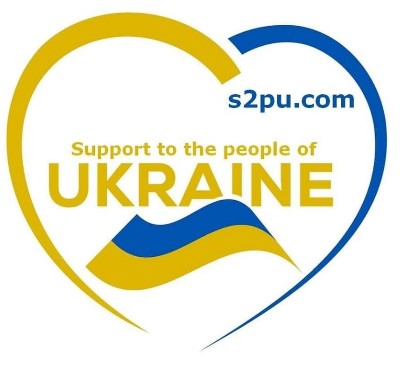
Comments powered by CComment